This is a question often asked and heard in the genetic genealogy community. Should I test my siblings too? Would it help our family history research if siblings test their DNA? The answer depends on the type of DNA test, the makeup of your family, and your research goals.
If you have already tested your own mitochondrial DNA to the highest level (FMS = Full Mitochondrial Sequence) to identify the haplogroup and mutations from your direct maternal line, then there is generally no need to test any full siblings, as their mtDNA should be the same as yours (barring heteroplasmy or current generation mutations).
If you have half-siblings by a different mother, then their mtDNA will differ from yours.
If you are male and have already tested your own Y-DNA to identify the haplogroup and STR marker values of your direct paternal line, then there is generally no need to also test any full brothers, as their Y-DNA should be the same as yours (barring any current generation mutations).
If you are female and have not been able to test your father’s Y-DNA, then testing a brother is ideal, as females do not inherit Y-DNA. If you have half-brothers by a different father, then their Y-DNA will differ from your father’s.

Yes, definitely encourage your siblings to do autosomal DNA tests (eg. AncestryDNA, MyHeritage DNA, Family Finder, 23andMe), as each child inherits a different 50% mix of atDNA from each of their parents at conception, and each sibling will have a different selection of matches in their results. Siblings should all match with close relatives up to and including 2nd cousins, but further back than that the results will be quite mixed… some siblings will have good matches that others won’t, and vice versa.
Each parent can only pass down half of their autosomal DNA to each child, so each child will inherit a random mix of segments from their parents, and consequently a random mix from each grandparent.
The diagram below demonstrates how the DNA can be recombined at each successive generation (this depicts just one chromosome out of the 22 autosomes).
Three children of the same parents can get quite different mixes of DNA from their grandparents, which means they may match relatives and cousins differently.

The following chromosome browser view shows two siblings (brothers) and the DNA they inherited from their grandparents through their mother.
The orange coloured segments were inherited from their mother’s father, and the blue coloured segments were inherited from their mother’s mother.
Note the different mixes on most chromosomes, and that some chromosomes were passed down intact from just one grandparent (eg. chromosomes 11, 21 & 22 for Grandchild 1, and chromosomes 14 & 22 for Grandchild 2).

Also note the percentage mix from each grandparent:
Some of your cousins will be detected as matches to some siblings, but will not be detected as matches to other siblings.
The chart below shows the likelihood of detecting cousins:
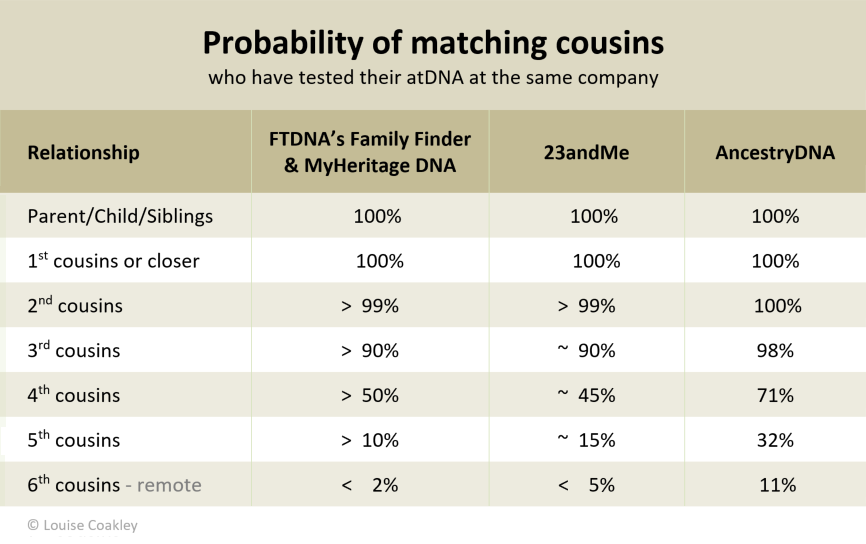
Sources: Family Tree DNA and 23andMe.
Source: AncestryDNA account – Matching Help & Tips
(Note: AncestryDNA match probabilities are higher than FTDNA’s and
23andMe’s due to AncestryDNA’s lower thresholds for including
matches, and due to filtering of matches to reduce false positives).
It is unheard of to-date for 2nd cousins who have tested their atDNA at the same company not to be detected as a match, but for 3rd and more distant cousins, it is worthwhile having additional family members tested to give you the best chance of detecting all your closest relatives. Even in my own family, some siblings match 3rd cousins, and others don’t.
The following examples use Family Finder’s Chromosome Browser tool to demonstrate how siblings can inherit quite different mixes of DNA and will match some relatives more than others, or not match others at all. The thresholds for all examples are set at the default 5cM.
DNA segments shared by one tester and his/her two 1st cousins (full siblings).
At the 1st cousin distance, there is plenty of shared DNA to detect the matches, but you can see how the segments differ between the two sibling 1st cousins, and there are large segments that may match one sibling but not the other. These two 1st cousins share 593cM and 668cM respectively.
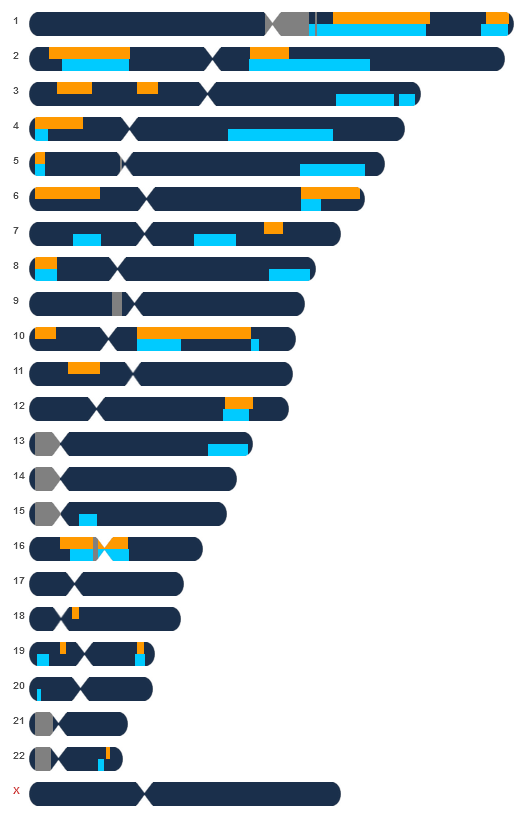
DNA segments shared by two testers (full siblings) and their four 1st cousins once removed (4 full siblings).
Notice the chromosome and segment differences between the two siblings’ matches to their same cousins.
At this distance there is still plenty of DNA in common with each cousin to easily detect their relationships.
Total shared segments for these 1st cousins once removed range from 247cM to 381cM.
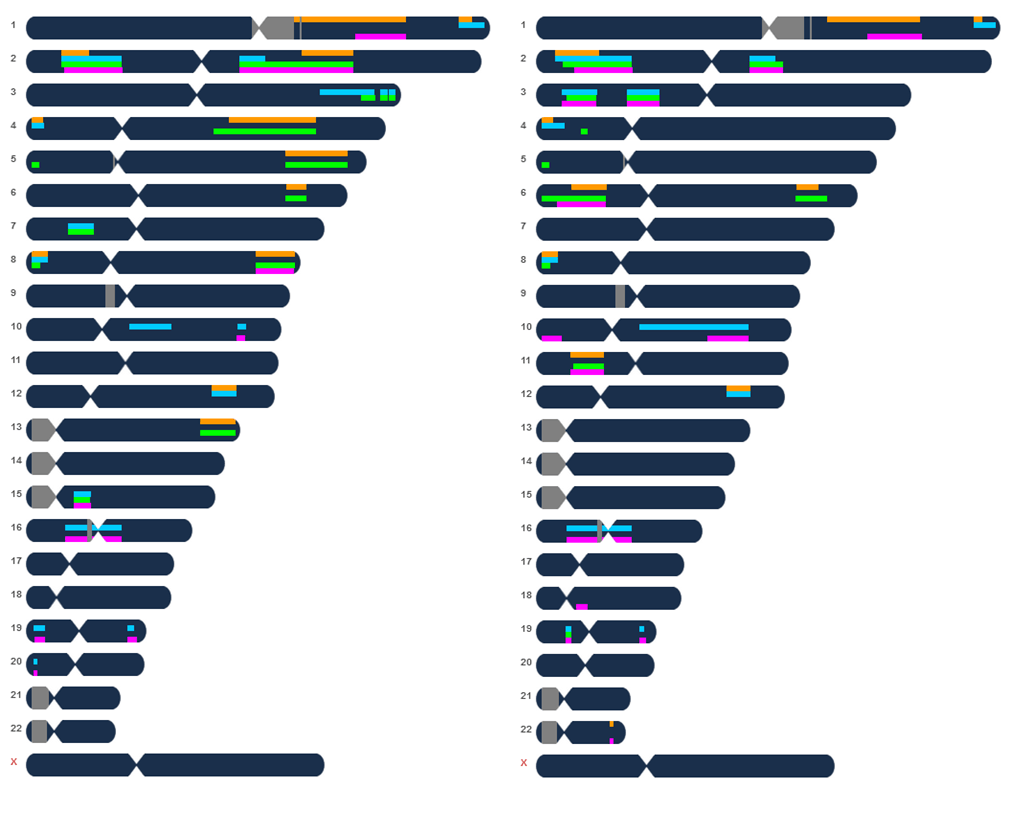
DNA segments shared by two testers (siblings )and their four 2nd cousins (4 siblings):
Notice the differences between the two siblings’ matches to their same 2nd cousins.
At this distance, the amount of shared DNA in common with each cousin is getting much less in total, smaller segments, and fewer matches in common with the siblings.
Total shared segments for these 2nd cousins range from 165cM to 210cM.
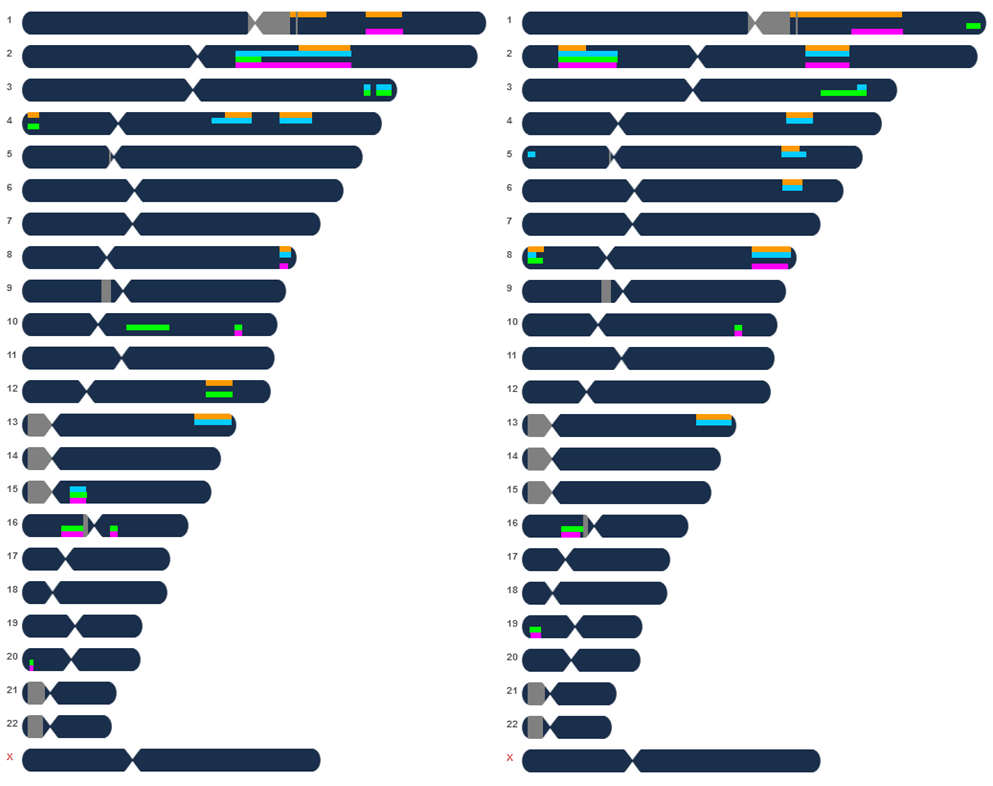
DNA segments shared by one tester and two 2nd cousins once removed (siblings).
At this distance, the siblings only shared two overlapping segments with their cousin.
They both match the cousin, but have each inherited different matching segments from their parent/grandparents.
Total shared segments for these 2nd cousins once removed was 50cM (blue) and 64cM (orange).
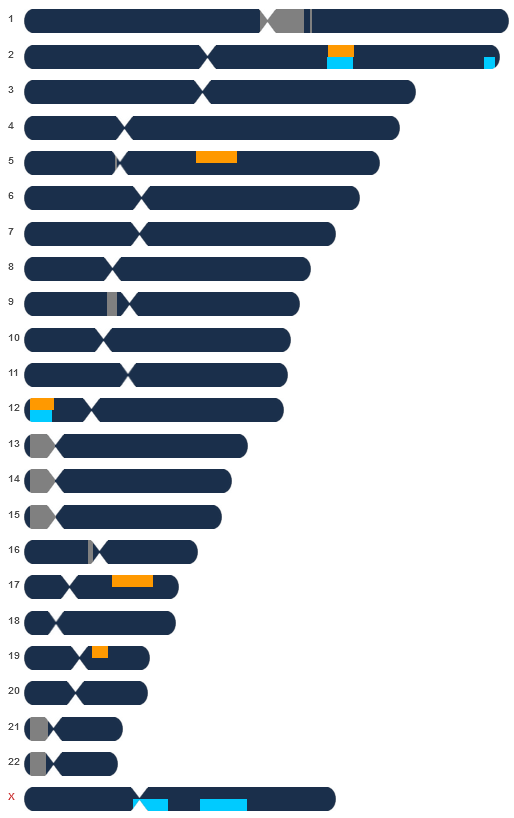
DNA segments shared by one tester and four 3rd cousins (4 siblings).
Alas! Notice that there are only 3 colours showing, as the 4th sibling is not detected by Family Finder.
Total shared segments for these three 3rd cousins range from 20cM to 57cM.
Family Finder predicted them as a 3rd cousin, 4th cousin, and a 5th cousin, and one was not detected at all.
By comparing the missing cousin on GEDmatch using a one-to-one comparison report, it was confirmed that there were genealogically-relevant matches on the same chromosomes as the other siblings, of 8cM and 9cM in length, but not totalling the minimum 20cM required to be included by FTDNA as a match.

The above examples demonstrate how easy it can be to miss cousin matches at the 3rd cousin distance and greater.
I have more examples similar to the above, from different relationship perspectives and distances.
In additon to the above, in my kits I also have:
If you only test yourself (or another relative) and no siblings, you may miss many cousin matches.
If you only test one cousin, it may not be one that matches you. Encourage your cousins to test their siblings if possible.
If you test multiple siblings and multiple cousin siblings, you have a much higher chance of detecting both your known cousins’ families, and many more unknown families. The same applies for testing your parents’ siblings, if possible.
If you don’t match a cousin as expected, don’t panic and assume that you’re not related after all, or that there was some hanky panky going on somewhere, or that a non-paternal event (NPE) occurred.
One-to-one comparison
Simply upload the two kits to GEDmatch and run a one-to-one comparison report set at lower cM & SNP thresholds, and you may find that you do match each other after all, but just not enough to meet the cM threshold required to be included in your match list.
Matches in common
Also check for matches in common, as cousins may not inherit the same DNA segments from the shared ancestor, but may both match other cousins in common.
I’m sure most people are aware of the importance of testing the oldest generations while you still can (parents, grandparents, great aunts, great uncles, etc). Once you’ve done that, test your siblings. If you don’t have any siblings, try to find some willing cousins or other extended family members instead.
Because siblings inherit different segments of DNA through their parents, they may also show different results in their ethnic makeup.
The example below shows the FTDNA myOrigins predictions of two parents at the top, and their four children below. Note the differences: only one child inherited the Norwegian (green) and only one child inherited the Southern European (purple).
Combinations and percentages are quite different, with one child only getting two clusters, and one getting as many as five.

This demonstrates that you shouldn’t take ethnic predictions too seriously, as they can vary within the same family. Individuals do not inherit DNA from all of their ancestors, nor do family members inherit it equally.
Results can also vary between testing companies, due to different reference populations, different algorithms, different timeframes for the estimates, and sibling samples being compared to different subsets of the reference populations.